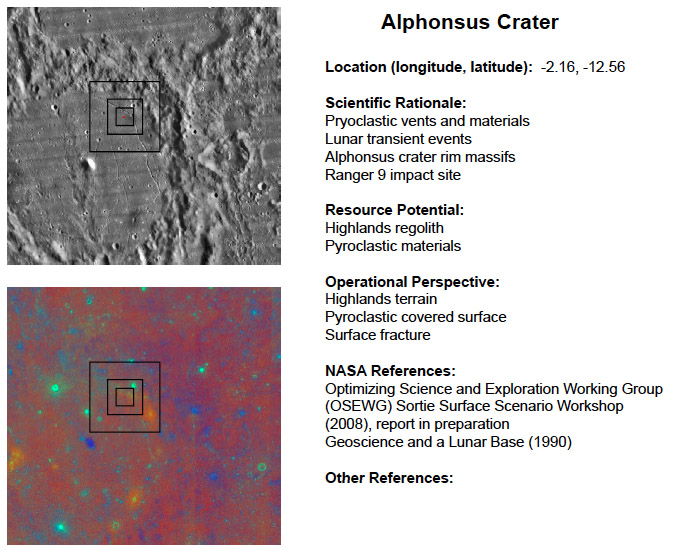Difference between revisions of "January 9, 2010"
| Line 3: | Line 3: | ||
<!-- ws:start:WikiTextHeadingRule:1:<h1> --> | <!-- ws:start:WikiTextHeadingRule:1:<h1> --> | ||
<!-- ws:start:WikiTextLocalImageRule:16:<img src="/file/view/LPOD-Jan9-10.jpg/112473911/LPOD-Jan9-10.jpg" alt="" title="" /> -->[[File:LPOD-Jan9-10.jpg|LPOD-Jan9-10.jpg]]<!-- ws:end:WikiTextLocalImageRule:16 --><br /> | <!-- ws:start:WikiTextLocalImageRule:16:<img src="/file/view/LPOD-Jan9-10.jpg/112473911/LPOD-Jan9-10.jpg" alt="" title="" /> -->[[File:LPOD-Jan9-10.jpg|LPOD-Jan9-10.jpg]]<!-- ws:end:WikiTextLocalImageRule:16 --><br /> | ||
| − | <em>sample target overview from [http://ser.sese.asu.edu/LSM/files/Cx-LROC-Tier1-FINAL.pdf | + | <em>sample target overview from [http://ser.sese.asu.edu/LSM/files/Cx-LROC-Tier1-FINAL.pdf Cx-LROC Tier 1 Targets]</em><br /> |
<br /> | <br /> | ||
| − | People love lists. They organize activities, provide goals, and give great satisfaction when items are crossed off. For the Moon there are a number of lists, my favorite - of course - is the [http://www.skyandtelescope.com/observing/objects/moon/3308811.html?c=y&page=1 | + | People love lists. They organize activities, provide goals, and give great satisfaction when items are crossed off. For the Moon there are a number of lists, my favorite - of course - is the [http://www.skyandtelescope.com/observing/objects/moon/3308811.html?c=y&page=1 Lunar 100]. There is now a shorter list of officially interesting targets. One of the goals of the Lunar Reconnaissance Orbiter Camera team is to acquire detailed images of 50 regions of interest to NASA's Constellation Program Office (CxPO), the modern equivalent of the Apollo Program, which will ultimately get people back on the Moon for long term exploration and utilization. Based mostly on reports from nearly 20 years ago CxPO selected 25 Tier 1 target areas (of highest priority) and 25 Tier 2 also rans. Each selected region has to be important scientifically, have resource potential, and be operationally varied. Each site is a 40 km square with nested areas inside for more intense investigation. Of the 25 Tier 1 sites, 19 are visible from Earth, as are 16 of the Tier 2s. I propose that these 35 Constellation sites be imaged and studied by amateurs as a way to build a connection to NASA's lunar exploration areas of interest over the next 20 years. The beginnings of a [http://the-moon.wikispaces.com/Cx35 page] for the Cx35 is being established on the <em>Moon Wiki</em> - I hope many people will contribute to it. I am sure that amateurs can create such a comprehensive description of each site that even NASA will use it. Perhaps in 2025 when astronauts land at one of these sites you can smile knowingly, having personally investigated it decades ago. Or maybe you will be one of those astronauts.<br /> |
<br /> | <br /> | ||
| − | <em>[mailto:tychocrater@yahoo.com | + | <em>[mailto:tychocrater@yahoo.com Chuck Wood]</em><br /> |
<br /> | <br /> | ||
<strong>Related Links</strong><br /> | <strong>Related Links</strong><br /> | ||
| − | [http://www.lpi.usra.edu/meetings/lro2009/pdf/6022.pdf | + | [http://www.lpi.usra.edu/meetings/lro2009/pdf/6022.pdf LEAG Review of Constellation Program Regions of Interest for Human Exploration of the Moon]<br /> |
<br /> | <br /> | ||
<hr /> | <hr /> | ||
| − | <div>You can support LPOD when you buy any book from Amazon thru [http://www.lpod.org/?page_id=591 | + | <div>You can support LPOD when you buy any book from Amazon thru [http://www.lpod.org/?page_id=591 LPOD!]<br /> |
</div> | </div> | ||
---- | ---- | ||
===COMMENTS?=== | ===COMMENTS?=== | ||
| − | + | Register, and click on the <b>Discussion</b> tab at the top of the page. | |
Revision as of 16:14, 11 January 2015
Cx35

sample target overview from Cx-LROC Tier 1 Targets
People love lists. They organize activities, provide goals, and give great satisfaction when items are crossed off. For the Moon there are a number of lists, my favorite - of course - is the Lunar 100. There is now a shorter list of officially interesting targets. One of the goals of the Lunar Reconnaissance Orbiter Camera team is to acquire detailed images of 50 regions of interest to NASA's Constellation Program Office (CxPO), the modern equivalent of the Apollo Program, which will ultimately get people back on the Moon for long term exploration and utilization. Based mostly on reports from nearly 20 years ago CxPO selected 25 Tier 1 target areas (of highest priority) and 25 Tier 2 also rans. Each selected region has to be important scientifically, have resource potential, and be operationally varied. Each site is a 40 km square with nested areas inside for more intense investigation. Of the 25 Tier 1 sites, 19 are visible from Earth, as are 16 of the Tier 2s. I propose that these 35 Constellation sites be imaged and studied by amateurs as a way to build a connection to NASA's lunar exploration areas of interest over the next 20 years. The beginnings of a page for the Cx35 is being established on the Moon Wiki - I hope many people will contribute to it. I am sure that amateurs can create such a comprehensive description of each site that even NASA will use it. Perhaps in 2025 when astronauts land at one of these sites you can smile knowingly, having personally investigated it decades ago. Or maybe you will be one of those astronauts.
Chuck Wood
Related Links
LEAG Review of Constellation Program Regions of Interest for Human Exploration of the Moon
COMMENTS?
Register, and click on the Discussion tab at the top of the page.



